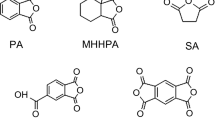Abstract
A compound, 3-ethyl-3-hydroxymethyloxetane (EHO), was synthesized with diethyl carbonate and trihydroxypropane as raw materials, 3-ethyl-3-allylmethoxy oxetane (EAMO) was synthesized with EHO and allyl bromide, and 1,1,3,3,5,5-hexamethyl-1,5-bis[(3-ethyl-3-methoxyoxetane)propyl]trisiloxane (HMBEMOPTS) was synthesized with EAMO and 1,1,3,3,5,5-hexamethyltrisiloxane (HMTS). HMBEMOPTS is a novel UV-curable oligomer. The test of photo-DSC shows the photosensitivity of HMBEMOPTS is better than the ordinary oxetane, 3-ethyl-3-[(3-ethyloxetan-3-yl)methoxymethyl]oxetane. HMBEMOPTS was mixed with bisphenol A type epoxy resin E-51 to prepare a cationic UV-curable system, and triarylsulfonium hexafluoroantimonate (UV-6976) was used as a cationic photoinitiator. The mechanical tests of coating films prove that when the mass fraction of HMBEMOPTS is 50%, the mechanical properties of the curing system are the best. The impact strength of the UV-curable films is measured to be 40 kg-cm and the flexibility is 2 mm; the tensile strength and flexural strength of the prepared specimens are 20.74 MPa and 13.43 MPa, respectively. The experimental results show that HMBEMOPTS can effectively improve photosensitivity and flexibility of the photosensitive resin.
Similar content being viewed by others
References
Gao M, Li L, Song Y. Inkjet Printing Wearable Electronic Devices[J]. J. Mater. Chem. C. Mater., 2017, 5(12): 2 971–2 993
Wang J, Song C, Zhong Z, et al. In Situ Patterning of Microgrooves via Inkjet Etching for a Solution-processed OLED Display[J]. J. Mater. Chem. C. Mater., 2017, 5(20): 5 005–5 009
Wei D, Liao B, Yong Q, et al. Castor Oil Based Hyperbranched Urethane Acrylates and Their Performance as UV-curable Coatings[J]. J. Macromol. Sci., Part A: Pure Appl. Chem., 2018, 55(5): 422–432
Cheng C, Zhang X, Huang Q, et al. Preparation of Fully Bio-based UV-cured Non-isocyanate Polyurethanes from Ricinoleic Acid[J]. J. Macromol. Sci., Part A: Pure Appl. Chem., 2015, 52(6): 485–491
Liu R, Zhang X, Zhu J, et al. UV-curable Coatings from Multiarmed Cardanol-based Acrylate Oligomers[J]. ACS. Sustain. Chem. Eng., 2015, 3(7): 1 313–1 320
Chittavanich P, Miller K, Soucek MD. A Photo-curing Study of a Pigmented UV-curable Alkyd[J]. Prog. Org. Coat., 2012, 73(4): 392–400
Qi Y, Li L, Fang Z, et al. Effects of Small Molecular Weight Silicon-containing Acrylate on Kinetics, Morphologies, and Properties of Free-radical/Cationic Hybrid UV-cured Coatings[J]. J. Appl. Polym. Sci., 2014, 131(16): 40 655
Boton L, Puguan JM, Latif M, et al. Synthesis and Properties of Quick-drying UV-curable Hyperbranched Waterborne Polyurethane Coating[J]. Prog. Org. Coat., 2018, 125: 201–206
Shen Z, Wu Y, Qiu S, et al. UV-thermal Dual-cured Polymers with Degradable and Anti-bacterial Function[J]. Prog. Org. Coat., 2020, 148: 105 783
Decker C. Kinetic Study and New Applications of UV Radiation Curing[J]. Macromol. Rapid. Commun., 2003, 23(18): 1 067–1 093
Li S, He Y, Nie J. Photopolymerization of Hybrid Monomer 3-(1-propenyl)oxypropyl Acrylate[J]. J. Photochem. Photobiol. A. Chem., 2007, 191(1): 25–31
Narewska J, Strzelczyk R, Podsiadly R. Fluoflavin Dyes as Electron Transfer Photosensitizers for Onium Salt Induced Cationic Photopolymerization[J]. J. Photochem. Photobiol. A. Chem., 2010, 212(1): 68–74
Park S, Kilgallon LJ, Yang Z, et al. Molecular Origin of the Induction Period in Photoinitiated Cationic Polymerization of Epoxies and Oxetanes[J]. Macromolecules, 2019, 52(3): 1 158–1 165
Al Mousawi A, Poriel C, Dumur F, et al. Zinc Tetraphenylporphyrin as High Performance Visible Light Photoinitiator of Cationic Photosensitive Resins for LED Projector 3D Printing Applications[J]. Macromolecules, 2017, 50(3): 746–753
Ligon SC, Liska R, Stampfl J, et al. Polymers for 3D Printing and Customized Additive Manufacturing[J]. Chem. Rev., 2017, 117(15): 10 212–10 290
Huang B, Han L, Wu B, et al. Application of Bis[2-(3,4-epoxycyclohexyl)ethyl]octamethyltetrasiloxane in the Preparation of a Photosensitive Resin for Stereolithography 3D Printing[J]. J. Wuhan Univ. Technol. — Mater Sci. Ed., 2019, 34(6): 1 470–1 478
Sun F, Jiang SL, Liu J. Study on Cationic Photopolymerization Reaction of Epoxy Polysiloxane[J]. Nucl. Instrum. Methods Phys. Res. B., 2007, 264(2): 318–322
Jang M, Crivello JV. Synthesis and Cationic Photopolymerization of Epoxy-functional Siloxane Monomers and Oligomers[J]. J. Polym. Sci. A. Polym. Chem., 2003, 41(19): 3 056–3 073
Lin Y, Stansbury JW. Kinetics Studies of Hybrid Structure Formation by Controlled Photopolymerization[J]. Polymer, 2003, 44(17): 4 781–4 789
Crivello JV, Sasaki H. Synthesis and Photopolymerization of Silicon-containing Multifunctional Oxetane Monomers[J]. J. Macromol. Sci., Part A: Pure Appl. Chem., 1993, 30(2–3): 173–187
Crivello JV, Sasaki H. Structure and Reactivity Relationships in the Photoinitiated Cationic Polymerization of Oxetane Monomers[J]. J. Macromol. Sci., Part A: Pure Appl. Chem., 1993, 30(2–3): 189–206
Zareanshahraki F, Jannesari A, Rastegar S. Morphology, Optical Properties, and Curing Behavior of UV-curable Acrylate-siloxane Polymer Blends[J]. Polym. Test., 2020, 85: 106 412
Huang B, Wu B, Han L, et al. Preparation of a Novel Cationic Photosensitive Resin (3D-SLR01) for Stereolithography 3D Printing and Determination of Its Some Properties[J]. J. Wuhan Univ. Technol. -Mater. Sci. Ed., 2019, 34(4): 761–768
Esposito Corcione C, Frigione M, Maffezzoli A, et al. Photo-DSC and Real Time-FT-IR Kinetic Study of a UV Curable Epoxy Resin Containing O-Boehmites[J]. Eur. Polym. J., 2008, 44(7): 2 010–2 023
Funding
Funded by the National Natural Science Foundation of China (No.21865017)
Author information
Authors and Affiliations
Corresponding author
Rights and permissions
About this article
Cite this article
Hu, S., Huang, B. & Chen, W. Synthesis of 1,1,3,3,5,5-hexamethyl-1,5-bis[(3-ethyl-3-methoxyoxetane)propyl]trisiloxane and Research on Its UV-curing Performance. J. Wuhan Univ. Technol.-Mat. Sci. Edit. 36, 942–948 (2021). https://doi.org/10.1007/s11595-021-2491-x
Received:
Accepted:
Published:
Issue Date:
DOI: https://doi.org/10.1007/s11595-021-2491-x




